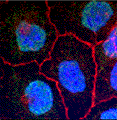Biochemistry, Department of
Document Type
Article
Date of this Version
2000
Abstract
In the green alga Chlamydomonas reinhardtii, a Leu290-to-Phe (L290F) substitution in the large subunit of ribulose-1,5-bisphosphate carboxylaseyoxygenase (Rubisco), which is coded by the chloroplast rbcL gene, was previously found to be suppressed by second-site Ala222-to-Thr and Val262-to-Leu substitutions. These substitutions complement the photosynthesis deficiency of the L290F mutant by restoring the decreased thermal stability, catalytic efficiency, and CO2/O2 specificity of the mutant enzyme back to wild-type values. Because residues 222, 262, and 290 interact with the loop between β strands A and B of the Rubisco small subunit, which is coded by RbcS1 and RbcS2 nuclear genes, it seemed possible that substitutions in this loop might also suppress L290F. A mutation in a nuclear gene, Rbc-1, was previously found to suppress the biochemical defects of the L290F enzyme at a post-translational step, but the nature of this gene and its product remains unknown. In the present study, three nuclear-gene suppressors were found to be linked to each other but not to the Rbc-1 locus. DNA sequencing revealed that the RbcS2 genes of these suppressor strains have mutations that cause either Asn54-to-Ser or Ala57-to-Val substitutions in the small-subunit βAyβB loop. When present in otherwise wild-type cells, with or without the resident RbcS1 gene, the mutant small subunits improve the thermal stability of wild-type Rubisco. These results indicate that the βAyβB loop, which is unique to eukaryotic Rubisco, contributes to holoenzyme thermal stability, catalytic efficiency, and CO2/2 specificity. The small subunit may be a fruitful target for engineering improved Rubisco.


Comments
Published in 14206–14211 PNAS, December 19, 2000, vol. 97, no. 26. Used by Permission